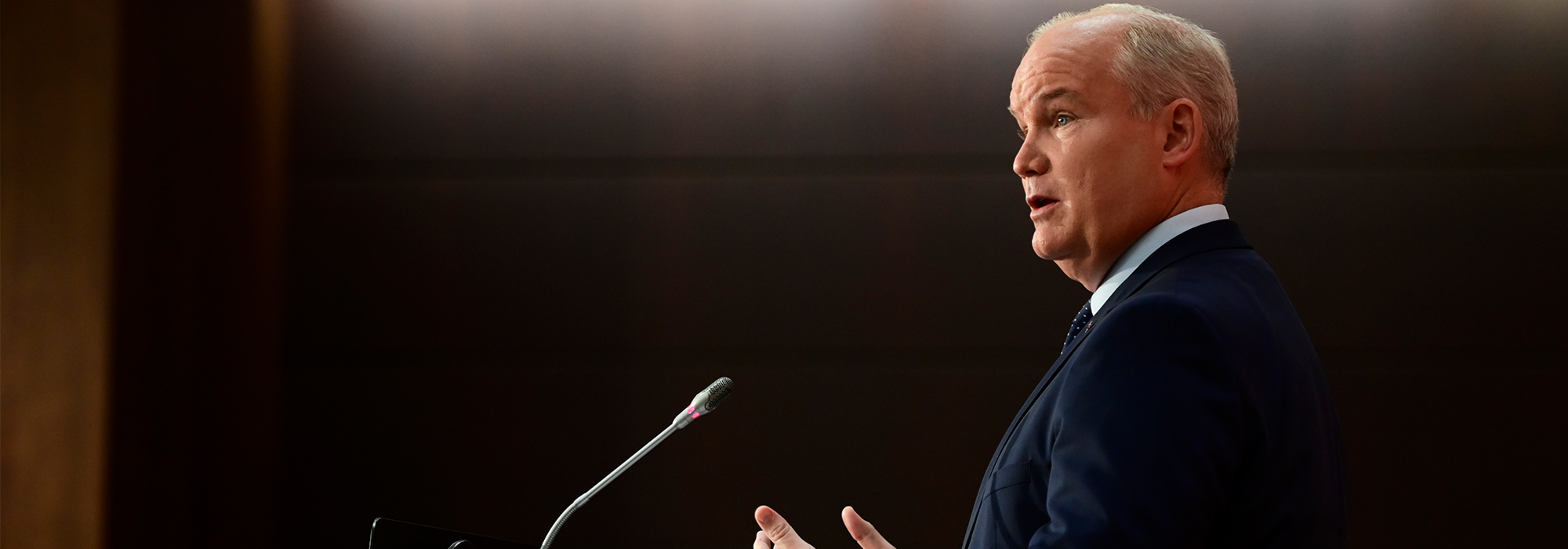
The installation of a new official Opposition leader into a minority parliament wouldn’t normally be a moment for thoughtful policy contributions across party lines. But we’re living in times that can be classified as far from normal. Despite the fact that the newly minted Conservative leader, Erin O’Toole, has a seat in Parliament, a well-resourced party apparatus and the government reeling from unfavourable news, he and his fellow Opposition party leaders are unlikely to topple the government this fall.
This leaves O’Toole in the difficult position of having to make budget demands of the government to address the implications of COVID-19 and the related economic crisis – demands that are in line with his political agenda. Most importantly, he must advise the government on spending that will both stimulate the Canadian economy in the short-term and address gaps created by the pandemic in the medium-term while not boxing in his hypothetical future government with long-term spending commitments.
This sounds like an extremely small needle to thread. But it is not impossible. A thoughtful policy contribution by the official Opposition would be proposing a strategic digital infrastructure fund aimed at replacing the public sector’s dated technology infrastructure. Such an initiative would improve services to Canadians while creating downstream fiscal savings and exportable Canadian tech and services.
The experience of COVID-19 and the related economic shutdown exposed that governments and the organizations they fund have not strategically invested in digital infrastructure to support and sustain essential services — such as health care, education and the justice system — in times of emergency. Courts have nearly ground to a halt. Non-COVID-related health matters and non-essential surgeries were paused. And public schools continue to scramble to provide some semblance of a curriculum online. This is despite the fact that the federal government alone spends $8 billion on technology products and services annually.
For example, the Government of Canada was unable to leverage its employment insurance (EI) software infrastructure to deliver the Canada Emergency Response Benefit in a timely fashion. The EI software was written in a generations-old coding language and wasn’t sufficiently scalable to service the vast number of Canadians out of work as a result of the pandemic. The government did come up with a patchwork solution. However, CRA experienced a significant hack, which halted the ability of Canadians to apply for emergency benefits.
Governments at all levels in Canada have a woeful track record in using technology procurement to achieve meaningful efficiencies in the delivery of services to citizens. This has been the result of dated approaches to software procurement that involve lengthy request-for proposal processes. Such processes provide little opportunity for developers to test their innovations and get meaningful feedback from the end users, whether they be employees of the government or Canadians accessing digital services.
The current approach has favoured large, multinational incumbents with the resources to go through the lengthy processes put in place for large, transformational technology projects. But the results haven’t delivered the intended outcomes. The Phoenix Pay System and the revitalization of the Government of Canada’s websites are two recent examples of the pitfalls government has faced in replacing mainstream technologies.
If government wants to address the past failures in transforming public services and creating economic opportunities through technology investments, it will have to be more precise about its desired policy outcomes.
Modernizing outdated technology procurement in government
A primary policy objective of the proposed digital infrastructure fund should be to support projects that have a clear mandate to deliver quantifiable efficiencies in the form of downstream fiscal savings inside government. The broader Canadian public sector is ripe for a thoughtful review of how technology could streamline organizational workflows. Such a review would empower government managers to direct the funds to technologies that execute mundane, repeatable tasks with speed and precision. Public servants, meanwhile, would be able to focus on more valuable interventions in the delivery of services. Downstream fiscal savings can ultimately be achieved humanely through attrition if the technologies developed actually sustain or improve service levels.
The government has to modernize procurement processes to enable more agile technology development processes that allow for developers to understand the needs of end users in real-time and alter the product or service as required without having to amend the contract. This can be achieved a transparent and accountable fashion by breaking down procurements into smaller projects. Timely delivery of those projects can be incentivized by paying upon the demonstration of performance of specific features and quickly moving to the next phase of the project.
Reshaping procurement policy to scale Canada’s tech sector
Delivering public sector efficiency through investments in its digital infrastructure is important to ensuring Canadians are well served. However, it alone will not increase the economic return to Canadian taxpayers in the form of job creation and tax windfalls from a digital infrastructure stimulus fund.
Governments can help spur meaningful economic development by shaping their procurement processes to support Canadian companies that own proprietary technologies or have the ability to develop, protect and commercialize such tech globally.
This approach would alleviate the risk of bilateral or multilateral trade disputes. Many of Canada’s recent international trade agreements open domestic public procurement, at all levels of government, to international bidding. By focusing strategic digital infrastructure investments in areas where Canadian firms can deliver on specific requirements with proprietary technologies or abilities, the federal government would remain in compliance with its trade obligations. Foreign firms would not be explicitly ruled out of the procurement process, but they would be at a strategic disadvantage.
A final, concurrent policy objective of the proposed digital infrastructure stimulus fund should be to evaluate the export potential of such technologies. While the public sector in Canada is one of the largest technology consumers domestically, the goal should not be to create a technology sector that is dependent on government procurement. Technologies should meet the needs of the Canadian market while responding to global customer requirements and standards. The Government of Canada could serve as the reference customer and the standard-setter for new technologies that aim to attract global customers.
The O’Toole Conservatives could demonstrate they are willing to make constructive policy and budget contributions by advocating for a time-limited, strategic digital infrastructure stimulus fund. The fund should be available to public sector organizations that bring forward thoughtful plans to improve public services and to create efficiencies and downstream fiscal savings through technologies developed by Canadian-owned-and-operated companies. The companies would be required to demonstrate the export potential of such products and services before stimulus funds are fully unlocked.
Most importantly, such a fund would, through fiscal savings and export-led economic growth, help address the estimated $343-billion deficit and $1.2- trillion debt that the Government of Canada and Canadians will be saddled with in the years to come.
This article is based on a policy essay by the author titled “Improving Public Services: A Strategic Approach to Digital Infrastructure – Tackling the deficit and addressing Canada’s productivity lag” as a part of the Public Policy Forum’s “Project Rebuild Canada”
Note to readers: This is a corrected version. An earlier version suggested that the Canada Revenue Agency was responsible for the federal government’s employment insurance software.
Photo : Conservative Leader Erin O’Toole holds a press conference on Parliament Hill in Ottawa on Sept. 2, 2020. THE CANADIAN PRESS/Sean Kilpatrick








